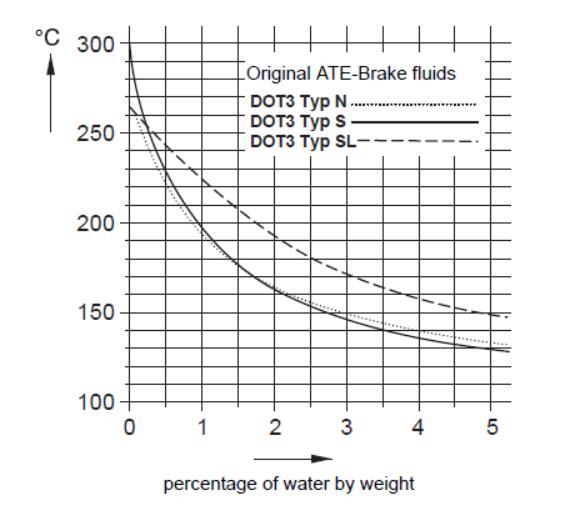Here is the illustration show you steps on how to change brake fluid for Jungheinrich ETM/V 10-12 forklift truck.
Related Contents:
Jungheinrich JETI ForkLift Judit-4 v4.37 4.34 2023 Free Download
Jungheinrich JETI ET 4.37 4.34 EPC 2023 Free Download
2023 Jungheinrich Forklift JETI SH v4.36 v4.34 Service Free Download
Procedures:
Brake Fluid
Brake fluid to DOT 3 and DOT 4 is hygroscopic, i.e., it possesses the peculiarity of constantly absorbing water from the at mospherichumidity.The boiling point of fresh brake fluid is between 260°cand 290°C.This value decreases considerably with increasing water absorption, as is shown by the diagram below

The heat generated by frequent use of the brakes is considerable and, if the brake fluid contains a relatively large amount of water,might cause steam bubbles, which can lead to the failure of the brake system.
To prevent this happening, it is essential to change the brake fluid at the intervals indicated in the operating instructions:
vehicles in normal use
=every 2000 hours or at yearly intervals vehicles used in cold storage
=every 1000 hours or half-yearly facilities intervals
Instruction for handling brake fluid
Brake fluid must always be stored in the original container.The container must be immediately and carefully closed after brake fluid has been taken from it.
According to the SAE-Specification, the maximum storage period of brake fluid, when kept in the unopened original container (sea-led), is five years.
Do not use brake fluid that has exceeded its useful life!
According to the applicable environment laws, brake fluid does not come under the provisions covering used oit. For this reason,brake fluid must always be collected and disposed of separately from used oil.
Drained brake fluid must never be used again.
Changing the brake fluid
Changing of the brake fluid must always be performed via the compensating vessel.In order to check the brake fluid for freedom of bubbles pass a transparent hose over the connection of thevent valve.Put the free end of the hose into a suitable container filled 1/3 with brake fluid.
Unscrew and remove the screwed plug from the compensating vessel.Open the vent valve and empty the compensating vessel down to the “MIN” mark by pumping the brake pedal.Top up the compensating vessel to the “MAX” mark using fresh brake fluid.This procedure must be repeated for all vent valves of the brake system and must be kept up until clear and bubble free brake fluid is discharged from the transparent hose. Upon completion of the brake fluid change, close the vent valve and replace the protective cap.
Changing of the brake fluid also ensures proper bleeding of the brake system as the fresh brake fluid entering the system pushes the old fluid contained in the system out through the vent valves.Top up the compensating vessel to the “MAX” mark and replace the screwed plug.
Bleeding the brake system
The brake system must be bled whenever the system has been opened (e.g. after repair operations or replacement of components), or when the brake fluid has been changed.
The bleeding procedure must be performed on all vent valves of the brake system.In the case of disc brake callipers (e.g.A 300),both valves must be bled (two valves per calliper).
Upon completion of the bleeding operations, dust caps must bereplaced on the vent valves!
Bleeding is through the main brake cylinder and by pumping ope-ration of the brake pedal (manual bleeding). When bleeding the brake system, it must be ensured that the brake fluid level in the compensating vessel does not face below the “MIN” mark. Up oncompletion of the bleeding operation, top up the compensating vessel with brake fluid to the “MAX” mark.
Check that the vent hole in the vessel’s cap is not blocked and clean if required.
lf, following the bleeding operation, the travel of the brake pedal is excessive, or if the pressure resistance is too soft, depress the brake pedal firmly several times and repeat the bleeding operation.
Cleaning the brake system
The brake system must be cleaned when internal contamination becomes excessive (formation of sludge in the compensating vessel).This is done by flushing the system with fresh brake fluid until clear fluid emerges from all vent valves.
Pressure gauges and measuring connections, as used for pressure testing on hydraulic systems,must never be used for tests and measurements on the brake system.
If hydraulic oil or mineral oil is inadvertently permitted to enter the brake system, this will cause the entire brake system to be in serviceable within a very short time. In this case,all rubber parts,including the brake hoses and brake light switches, must be replaced.
The brake tubes (pipes) must be cleaned with Tri, rinsed with white spirit and finally blown through using dry compressed air.
For more Jungheinrich trouble repair case,please refer to Jungheinrich Trouble Repair